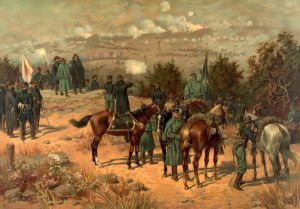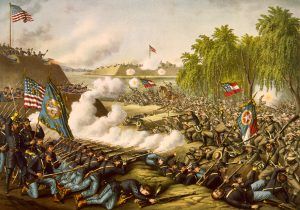Confederate Heartland Offensive (June-October 1862)
Also called the Kentucky Campaign, this series of maneuvers and battles took place in East Tennessee and Kentucky in 1862. From June through October, Confederate forces under Braxton Bragg and Edmund Kirby Smith’s commands launched a series of movements to outflank the Army of the Ohio and draw the border state of Kentucky into the Confederate States of America. Though the Confederates gained some early successes, their progress was stopped decisively at the Battle of Perryville, leaving Kentucky in Union hands for the rest of the war.
Chattanooga (June 7-8, 1862) – The first battle of this campaign was in Hamilton County, Tennessee, and Chattanooga. In late Spring, the Confederacy split its forces in Tennessee into several small commands to complicate Federal operations. The Union had to redistribute its forces to counter the Confederate command structure changes. Major General Ormsby Mitchel received orders to go to Huntsville, Alabama, to repair railroads in the area. Soon, he occupied more than 100 miles along the Nashville & Chattanooga and Memphis & Charleston Railroads. In May, Mitchel and his men sparred with Major General Edmund Kirby Smith’s men.
After Mitchel received command of all Federal troops between Nashville and Huntsville, on May 29, he ordered Brigadier General James Negley with a small division to lead an expedition to capture Chattanooga.
This force arrived on June 7th, and Negley ordered the 79th Pennsylvania Volunteers out to reconnoiter. It found the Confederates entrenched on the opposite side of the river along the banks and atop Cameron Hill. Negley brought up two artillery batteries to open fire on the Rebel troops and the town and sent infantry to the river bank to act as sharpshooters. The Union bombardment of Chattanooga continued throughout the June 7th and until noon on the 8th. The Confederates replied, but it was uncoordinated since the undisciplined gunners were allowed to do as they wished. On June 10, Smith, who had arrived on the 8th, reported that Negley had withdrawn and the Confederate loss was minor. A Union victory, the assault resulted in and 23 Union and 65 Confederate casualties.
Murfreesboro (July 13, 1862) – The second battle of the campaign was in Rutherford County, Tennessee. On June 10, 1862, Major General Don Carlos Buell, commanding the Army of the Ohio, started a leisurely advance toward Chattanooga, which Union Brigadier General James Negley and his force threatened on June 7-8. In response to the threat, the Confederate government sent Brigadier General Nathan B. Forrest to Chattanooga to organize a cavalry brigade. By July, the Confederate Cavalry under Forrest and Colonel John Hunt Morgan were raiding into Middle Tennessee and Kentucky. Perhaps, the most dramatic of these cavalry raids was Forrest’s capture of the Union Murfreesboro garrison on July 13, 1862. Forrest left Chattanooga on July 9th with two cavalry regiments and joined other units on the way, bringing the total force to about 1,400 men. The major objective was to strike Murfreesboro, an important Union supply center on the Nashville & Chattanooga Railroad, at dawn on July 13th. The Murfreesboro garrison was camped in three locations around town. It included detachments from four units comprising infantry, cavalry, and artillery, under Brigadier General Thomas T. Crittenden, who had just arrived on July 12th. Between 4:15 and 4:30 am on July 13, Forrest’s cavalry surprised the Union pickets on the Woodbury Pike, east of Murfreesboro, and quickly overran a Federal hospital the camp of the 9th Pennsylvania Cavalry Regiment detachment. Additional Rebel troops attacked the camps of the other Union commands and the jail and courthouse. By late afternoon all of the Union units had surrendered to Forrest’s force. The Confederates destroyed much of the Union supplies and tore up railroad tracks in the area, but the raid’s main result was the diversion of Union forces from a drive on Chattanooga. Along with Morgan’s raid into Kentucky, this raid made possible Confederate General Braxton Bragg’s concentration of forces at Chattanooga and his early September invasion of Kentucky. Resulting in a Confederate victory, the estimated casualties were 890 Union and 150 Confederate.
The Confederate Heartland Offensive continued into Kentucky at the Battle of Richmond on August 29-30, resulting in a Confederate victory; to the Battle of Munfordville on September 14-17, also resulting in a Confederate and victory; and finally, to the last battle of the campaign at Perryville on October 8, 1862. This last battle resulted in a strategic Union victory. The Confederate offensive was over, and the Union controlled Kentucky.
Iuka and Corinth Operations (September-October, 1862)
During the late summer of 1862, Confederate forces attempted a three-pronged strategic advance into the North. The only coordinated Confederate attempt to carry the conflict to the enemy ended in disaster. The offensive strategy included Antietam, Maryland, Kentucky, and the northern Mississippi campaign referred to as the Iuka and Corinth Operations. This third campaign into Mississippi led to the devastating and little-studied defeats at Iuka and Corinth, Mississippi — defeats that would open the way for Grant’s attack on Vicksburg, Mississippi. The last battle of the Iuka and Corinth Campaign took place in Tennessee.
Hatchie’s Bridge (October 5, 1862) – Also called the Battle of Davis Bridge and the Battle of Metamora, this last conflict of the Iuka and Corinth Campaign took place in Hardeman and McNairy Counties of Tennessee after Major General Earl Van Dorn’s Confederate Army of West Tennessee retreated from Corinth, Mississippi on October 4, 1862.
Union Major General William Rosecrans did not send forces in pursuit until the morning of October 5th. In the meantime, Major General Edward O.C. Ord, commanding a detachment of the Army of West Tennessee, was advancing on Corinth to assist Rosecrans. On the night of October 4-5, he and his men were encamped near Pocahontas, Tennessee. Between 7:30 and 8:00 am the next morning, his force encountered Union Major General Stephen A. Hurlbut’s 4th Brigade, Army of West Tennessee, in the Confederate’s front. Ord took command of the now-combined Union forces and pushed Van Dorn’s advance, Major General Sterling Price’s Army of the West, back about five miles to the Hatchie River and across Davis’ Bridge. After accomplishing this, Ord was wounded, and Hurlbut assumed command. While Price’s men were hotly engaged with Ord’s force, Van Dorn’s scouts looked for and found another crossing of the Hatchie River. Van Dorn then led his army back to Holly Springs, Mississippi. Ord had forced Price to retreat, but the Confederates escaped capture or destruction. Although they should have done so, Rosecrans’ army had failed to capture or destroy Van Dorn’s force. Resulting in a Union victory, the estimated casualties were 500 Union and 400 Confederates.


